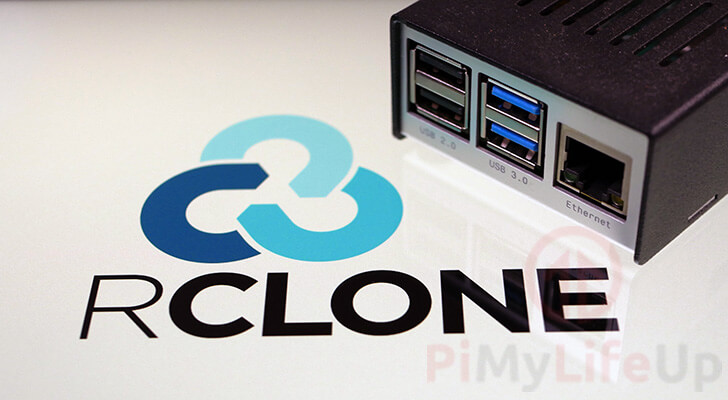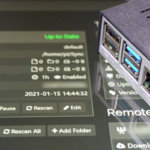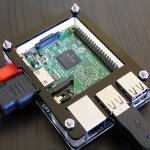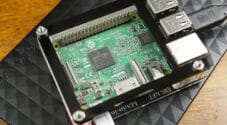This project will show you how you can install the Rclone software to your Raspberry Pi.

Rclone is an open-source software designed to let you manage content on cloud services such as Google Drive and Amazon S3.
Using this software, you can do a various tasks, such as synchronizing files between your Raspberry Pi and your cloud provider. It’s even possible to mount cloud services as if they were actual disks on your Raspberry Pi.
With support for over 50 different backends, it is hard to go past using Rclone to connect to your cloud storage provider. Some of the most prominent supported cloud providers are Amazon Web Services, Microsoft OneDrive, and Google Drive.
Rclone can even be used to interact with your self hosted cloud services such as OwnCloud and Nextcloud.
Best of all, the software is relatively straightforward to use. Rclone walks you through the connection process for each of its available backends.
Equipment
Installing Rclone to your Raspberry Pi requires just a few small parts that you likely already have on hand.
Recommended
Optional
We tested this tutorial using a Raspberry Pi 400, running the latest release of Raspberry Pi OS Buster.
Preparing your Raspberry Pi for Rclone
We should first prepare our Raspberry Pi so that we can set up and install Rclone with relative ease.
This involves updating our operating system and installing some base packages.
1. Let us begin by ensuring we have an updated operating system to work off.
You can update Debian based operating systems such as Raspberry Pi OS by using the following two commands.
sudo apt update
sudo apt upgradeCopy2. Next, we need to make sure that we have the unzip package installed.
Without this, we will be unable to extract the latest version of Rclone to our Raspberry Pi.
sudo apt install unzipCopyInstalling Rclone on the Raspberry Pi
While we can install Rclone from the package repository, it means we would be running an out of date version.
The downside of using an out of date version is that cloud services can often change, meaning what used to work might get broken.
To work around this, we can download the latest builds directly from the Rclone project themselves.
1. We are now ready to download the latest stable release of Rclone to our Raspberry Pi.
Run the following wget command on your device to download the latest ARM release.
wget https://downloads.rclone.org/rclone-current-linux-arm.zipCopy2. Once Rclone has finished downloading to your Raspberry Pi, we can extract the archive.
Run the following command to use the unzip package we installed to extract Rclone.
unzip -j -d rclone-temp rclone-current-linux-arm.zipCopyWe use two arguments with this command. The first argument (-j) tells the unzip software to extract everything to the top level only and not to create any directories.
The second argument (-d <DIRECTORY>) tells the unzip command that we want to extract all the files into the specified directory.
In our case, this directory will be called “rclone-temp“.
3. With the files extracted, we now need to move them into positions where the operating system knows where they are.
The first file we need to move is the Rclone binary. We will move this binary to the “/usr/bin” directory as the command line automatically uses that location to find packages.
Run the following command to move the binary to the correct location.
sudo mv ~/rclone-temp/rclone /usr/bin/rcloneCopy4. Next, let us set up the manual pages for Rclone.
We do this so that you will get manual for the program when you type in “man rclone“.
Let us move this folder from the extracted folder to the man pages folder at “/usr/share/man/man1“.
sudo mv ~/rclone-temp/rclone.1 /usr/share/man/man1/rclone.1Copy5. We need to clean up some of the permissions with our files to ensure the root user owns the file and not our pi user.
In the next command, we will give the root user ownership of the file we just moved by using chown.
sudo chown root: /usr/bin/rcloneCopyChanging the permissions will ensure someone with access to the pi user can’t swap out the rclone binary.
6. Finally, let’s clean up after our installation by deleting our temporary directory and the zip file we downloaded.
rm ~/rclone-current-linux-arm.zip
rm -r -f ~/rclone-tempCopyConnecting to a Remote using Rclone
Now that we have installed Rclone on our Raspberry Pi, we can finally move on to utilizing it.
We will show you the first few steps to get you started with the software for this example.
1. Before you can connect to your remote, you will need to create a new config.
Begin Rclone’s configuration process by using the following command.
rclone configCopy2. The first message will ask you what you want to do.
You may see a warning about the config file not being found. This is not a problem as we haven’t created any remotes yet.
To begin creating a new remote connection, type in n, then press ENTER.
2021/01/19 02:15:20 NOTICE: Config file "/home/pi/.config/rclone/rclone.conf" not found - using defaults
No remotes found - make a new one
n) New remote
s) Set configuration password
q) Quit config
n/s/q>3. Next, you will need to give a name for your new remote connection.
For our case, we are going to name our “pimylifeup Rclone“, but you can name the connection whatever you want.
name>4. You will now see a list of the various backends that Rclone can connect to without issue.
Please note that this list may have changed by the time you follow this tutorial yourself.
For example, if we wanted to use Google Drive, we will need to type in the number 13.
Type of storage to configure.
Enter a string value. Press Enter for the default ("").
Choose a number from below, or type in your own value
1 / 1Fichier
\ "fichier"
2 / Alias for an existing remote
\ "alias"
3 / Amazon Drive
\ "amazon cloud drive"
4 / Amazon S3 Compliant Storage Provider (AWS, Alibaba, Ceph, Digital Ocean, Dreamhost, IBM COS, Minio, Tencent COS, etc)
\ "s3"
5 / Backblaze B2
\ "b2"
6 / Box
\ "box"
7 / Cache a remote
\ "cache"
8 / Citrix Sharefile
\ "sharefile"
9 / Dropbox
\ "dropbox"
10 / Encrypt/Decrypt a remote
\ "crypt"
11 / FTP Connection
\ "ftp"
12 / Google Cloud Storage (this is not Google Drive)
\ "google cloud storage"
13 / Google Drive
\ "drive"
14 / Google Photos
\ "google photos"
15 / Hubic
\ "hubic"
16 / In memory object storage system.
\ "memory"
17 / Jottacloud
\ "jottacloud"
18 / Koofr
\ "koofr"
19 / Local Disk
\ "local"
20 / Mail.ru Cloud
\ "mailru"
21 / Mega
\ "mega"
22 / Microsoft Azure Blob Storage
\ "azureblob"
23 / Microsoft OneDrive
\ "onedrive"
24 / OpenDrive
\ "opendrive"
25 / OpenStack Swift (Rackspace Cloud Files, Memset Memstore, OVH)
\ "swift"
26 / Pcloud
\ "pcloud"
27 / Put.io
\ "putio"
28 / QingCloud Object Storage
\ "qingstor"
29 / SSH/SFTP Connection
\ "sftp"
30 / Sugarsync
\ "sugarsync"
31 / Tardigrade Decentralized Cloud Storage
\ "tardigrade"
32 / Transparently chunk/split large files
\ "chunker"
33 / Union merges the contents of several upstream fs
\ "union"
34 / Webdav
\ "webdav"
35 / Yandex Disk
\ "yandex"
36 / http Connection
\ "http"
37 / premiumize.me
\ "premiumizeme"
38 / seafile
\ "seafile"
Storage>5. At this point, the steps will change dramatically depending on what backend you want to connect to.
For example, if you connect to OneDrive from your Raspberry Pi, the steps will differ from what you would use for Google.
Follow the steps provided to connect your Raspberry Pi to your chosen remote.
Updating the Rclone Software
If you have been using Rclone for a while, you may want to update to the latest available version.
These steps are very similar to the installation steps, so we won’t be explaining them too much.
1. First, download the latest available version of the Rclone software.
wget https://downloads.rclone.org/rclone-current-linux-arm.zipCopy2. Next, extract the archive to the current directory.
unzip -j -d rclone-temp rclone-current-linux-arm.zipCopy3. Now, move the new Rclone binary to replace the old one.
sudo mv ~/rclone-temp/rclone /usr/bin/rcloneCopy4. Now we just need to patch up the permissions of our newly replaced Rclone binary.
sudo chown root: /usr/bin/rcloneCopy5. You should now be able to use your newly updated Rclone installation.
Before continuing, we should clean up the files we just downloaded by using the two commands below.
rm ~/rclone-current-linux-arm.zip
rm -r -f ~/rclone-tempCopyConclusion
Hopefully, at this point, you will now have Rclone installed on your Raspberry Pi.
Rclone is a powerful piece of software that can be used to clone files from various cloud providers.
It’s a reliable alternative to setting up client-specific software for services like Dropbox or gDrive.
If you run into any issues with getting Rclone to run on your Pi, feel free to leave a comment below.









